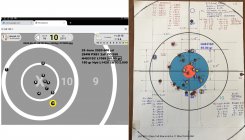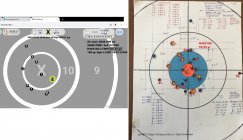With open mics being a trouble spot, I wonder if anyone has tried some sort of shroud around the outer half of the mic and put some sort of thin foam inside to reduce sound reflection. Might work.
Quickly reading through this thread Warren what you are describing are the 8mic Carbon fiber mics we have with our SMT G2 system. Overall they are better, but when someone is completely off target I miss the old 5mic system as you could see WAY around the target.
Quickly reading through here as a club that has ran SMTs since 2016 here is what we've found.
1. It is all about your setup and mic placement. If you just slap your sensors on a frame and expect them to work they won't you accuracy will suck. You need to make sure they are in a square/rectangle the distances are the same and they are at right angles to each other and that the sensors are perpendicular to the face of the target. Frame I threw together in the backyard wasn't all squared and accuracy sucked until I did the above.
2. The shooters need to be perpendicular to the target frames. If you are shooting at an angle to your target it won't plot accurately. This was a reason that Keith Glassock and I got into it a couple years ago. At Rattlesnake they shoot at an angle so there SMT systems didn't work. He came out to our range for an F-Class team match and the SMT system was incredibly different experience because of shooting straight into the targets and #1 and the reasons below. On the target I use in the back yard that I just stick in the ground if it's lined up properly the velocities are correct. If it isn't then I have velocities 100yds away with 223's shooting 77s that say 3200fps or faster. This is due to me and setup not the system.
3. You need rigid frames. We use welded aluminum frames designed by Jeff Hopkins they don't flex they don't move. They sit on 2x4 uprights, the setup can withstand up to 50-55mph winds and thats when the 2x4s snap and then your heart starts racing (don't ask how we know).
4. Your centers NEED to be exactly centered and located exactly the same. On our 6x6 backer we have corner slots for 4x4 chloroplast inserts for all the different target blacks. These are located the same on each frame. On the 4x4s the vinyl target faces are perfectly centered. Jeff took a lot of time designing this and his brother Monty (who we get the centers from) make sure they are lined up. This keeps the target zeros the same.
5. Carrier spacing is very important if your carriers are very close together the sounds of the adjacent bullets will mess with the targets. This is why some ranges (Wildcat in IN for example) will have issues with rapids where as we don't because our carriers are farther apart. The simple fix they had for this is they shoot every other target. More on this below.
6. If you've done all the above then you can actually judge the accuracy of the ETs. We have noticed certain wind conditions where we do have issues, shots get plotted but the plots aren't accurate. On the SMT (shot marker is the same as its code is based off of SMT) you will get X/Y and/or side plunge errors. What this is based on the sonic cone the system is throwing a plot up there but it tells you hey this isn't accurate. We ignore those shots and only happens with a strong head wind out of the south at our range back at 1k. Normally the issue is with 223's and service rifles at 1000, but anything else that is sonic but barely on those windy days can show it. SMT targets try to "learn" what angle your sonic cone is coming in and one thing we've noticed is if on windy days and people are having issues getting on paper it makes that "learning" difficult and sometimes I've saved (reset) the targets for people having issues once they've gotten on paper and it has been fixed. That being said when I shoot my 223 at 1k on a windy day I get maybe 1 or 2 *'s in a string for those errors it isn't much.
The main issues you have with missing/dropped shots is because the sound signal isn't strong enough and the system records it but can't plot it. Example you have a 223 Palma rifle shooting next to a 7mm Any. That 7mm is going to have a 180 cracking across the target at mid upper 1500s if not in the 1600s. The 223 with a smaller bullet is going to be in the upper 1300s maybe low 1400s. On a calm day the targets here each crack and plot and life is good. However if its a windy day those sounds get masked and the little bullet can get lost. If your spacing on the frames is closer then that makes it even worse. Steve Rortvedt and John Friguglietti noticed that at Lodi compared to our place. Up at Lodi their 223s were having all kinds of shots dropped and accuracy sucked. Came to our place they worked fine. Wasn't any difference in the rifles just the range/target setups. Reason 308 guns didn't have the issue is because the crack is louder and the targets can pick it up. I also personally think the mic sharing and not having the mic located on the target frames is an issue there.
7. Accuracy isn't scaled and the closer you are the less accurate they are. Example if say you have a .5" error at 100 yards it does not equal a 5" error at 1000yds, it is still a .5" error. Whatever the value is you have to ask yourself and I've seen it done and have done it when marking a target how many times have you looked at a shot that is just there and is very close to a line your not sure but you give it to them. Or when the shooter challenges and they come down and pull the plug out the plug enlarged hole then breaks the line and the person wins the challenge and gets the higher value. That is an error but it isn't measurable. Is there some error with ET's yes but each target handles it the same. Same way with those two piece paper repair centers (F-Class has single) they aren't perfect circles when glued up. We have some rather hard holders who frequently shoot our range or come visit us once or twice a year and they don't (or maybe they just don't say it) question the accuracy. Most the comments I hear is the shooter saying they should have held off more, etc.
I did a VERY crude accuracy test of our system back in 2018 (Adam criticized me for it and rightly so) just to show what the 8mic system would do in a match situation where I'm not trying to squeeze every nth accuracy out of it. I just plopped down and shot. At that time we were still using the paper targets on the 4x4s and they weren't exactly in the center so caused some error, and the method we used to hold the 4x4s, didn't locate them as well as our corner pocket system did. Also this was with the first generation of 8 mic algorithms in the G2s at the time I did this test the solo software was the most accurate in calculating followed by the 5 mic G2 and then the 8 mic G2 per Daniel. Shortly after this the Solo stuff was ported over for G2 use and has been improved several times since. All being said I wasn't following #2 and #4 above. From that test at 300/500/600 yards the SD error was .17" at 300/600 and .2" at 500. This was done on a rather windy/switchy day and that .17" error back at 1000 is only going to be 0.017MOA well inside what any rifle can do. While yes people will say well that can cost a big match and yes it can, also if a person would have adjusted for the wind a smidge better it wouldn't be an issue. I liken that excuse to I didn't shoot good so I need something to blame other than myself. My score on paper during the test was 1 point higher than what was plotted on the screen. The point difference was a shot that I called a corner 9, came up a corner 9 but when checking it was just barely a 10. I need to get out and redo the test sometime and actually line up perpendicular on the target. The old test from 2018 is up on our website if you want to read it.
Are ET's perfect no, but then neither are pulled targets. The majority of errors we have had were due to us, not the system. With ET's everyone gets the same pit service also everyone gets the same paper plotting, and everyone's scoring target is the same size. These are all errors that you can't measure with pulled targets.
Hopefully the above helps















